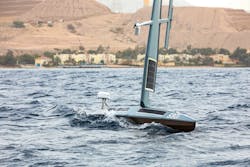U.S. Navy tests long-endurance unmanned surface vessels and onboard sensors for wide-area ocean surveillance
WASHINGTON – The sea is vast, and full of secrets, and the U.S. Navy is in the business of knowing them. This fall, in the Red Sea and the Persian Gulf, the Navy experimented with new unmanned surface vessels (USVs). These machines, the Saildrone and MANTAS T-38 USV, are forays into launching future flotillas of autonomous sensing machines, all of which promise to expand the scope of what Navy commanders can know about the waters they patrol. Popular Science reports. Continue reading original article
The Military & Aerospace Electronics take:
12 Jan. 2022 -- The Saildrone Explorer for ocean surveillance looks like a windsurfer without a human clinging onto it. With a 23-foot-long body and standing at 16 feet tall, the Explorer is mostly sail. It draws electrical power from the sun and propulsive power from the wind. Under sail power, the drone travels between 2 and 7 miles per hour. These vehicles can sail for long distances and durations, with the company claiming that the drones can operate for as long as 12 months on a mission before it needs to come ashore for maintenance.
Saildrones can be outfitted with a range of sensors for wind speed and direction, for air temperature and humidity, for measuring the salinity and magnetic field of the ocean surface, and even for detecting fish biomass and mammal presence under the surface. In addition, the Saildrones can record above-the-surface video and use machine learning algorithms to detect targets; this is what interests the Navy.
The cameras and processing on the Saildrone “deliver real-time, visual detection of targets that are otherwise not transmitting their position,” the company claims, which can then be paired with radar, acoustic sensors, and other detection systems to confirm a sighting. In November, the Navy announced that it would base these Saildrones out of Jordan’s naval base in Aqaba, on the Red Sea.
Related: DARPA eyes ocean surveillance with unmanned sensor floats
John Keller, chief editor
Military & Aerospace Electronics

